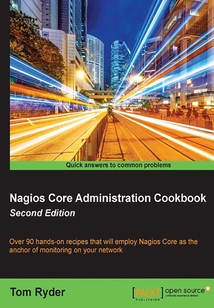舉報 

會員
Nagios Core Administration Cookbook(Second Edition)
最新章節:
Index
IfyouareanetworkorsystemadministratorandarelookingforinstructionsandexamplesonworkingwithNagiosCore,thenthisbookisforyou.Somebasicshellcommand-lineexperienceisrequired,andsomeknowledgeofscriptingwouldbehelpfulwhenwediscusshowpluginswork.
目錄(118章)
倒序
- 封面
- 版權信息
- Credits
- About the Author
- About the Reviewer
- www.PacktPub.com
- Preface
- Chapter 1. Understanding Hosts Services and Contacts
- Introduction
- Creating a new network host
- Creating a new HTTP service
- Creating a new e-mail contact
- Verifying configuration
- Creating a new hostgroup
- Creating a new servicegroup
- Creating a new contactgroup
- Creating a new time period
- Running a service on all hosts on a group
- Chapter 2. Working with Commands and Plugins
- Introduction
- Finding a plugin
- Installing a plugin
- Removing a plugin
- Creating a new command
- Customizing an existing command
- Using an alternative check command for hosts
- Writing a new plugin from scratch
- Implementing threshold checks in a plugin
- Using macros as environment variables in a plugin
- Chapter 3. Working with Checks and States
- Introduction
- Specifying how frequently to check a host or service
- Changing thresholds for PING RTT and packet loss
- Changing thresholds for disk usage
- Scheduling downtime for a host or service
- Managing brief outages with flapping
- Adjusting flapping percentage thresholds for a service
- Chapter 4. Configuring Notifications
- Introduction
- Configuring notification periods
- Configuring notifications for groups
- Choosing states for notification
- Specifying the number of failed checks before notification
- Automating contact rotation
- Defining an escalation for repeated notifications
- Defining a custom notification method
- Filtering notifications based on a host or service value
- Chapter 5. Monitoring Methods
- Introduction
- Monitoring PING for any host
- Monitoring SSH for any host
- Checking an alternative SSH port
- Monitoring mail services
- Monitoring web services
- Checking that a website returns a given string
- Monitoring database services
- Monitoring the output of an SNMP query
- Monitoring a RAID or other hardware device
- Creating an SNMP OID for monitoring
- Chapter 6. Enabling Remote Execution
- Introduction
- Monitoring local services on a remote machine with NRPE
- Setting the listening address for NRPE
- Setting allowed client hosts for NRPE
- Creating new NRPE command definitions securely
- Giving limited sudo(8) privileges to NRPE
- Using check_by_ssh with key authentication instead of NRPE
- Using check_mk instead of NRPE
- Chapter 7. Using the Web Interface
- Introduction
- Using the Tactical Overview
- Viewing and interpreting availability reports
- Viewing and interpreting trends
- Viewing and interpreting notification history
- Adding comments on hosts or services in the web interface
- Viewing configuration in the web interface
- Scheduling checks from the web interface
- Acknowledging a problem via the web interface
- Chapter 8. Managing Network Layout
- Introduction
- Creating a network host hierarchy
- Using the network map
- Choosing icons for hosts
- Establishing a host dependency
- Establishing a service dependency
- Monitoring inpidual nodes in a cluster
- Using the network map as an overlay
- Chapter 9. Managing Configuration
- Introduction
- Grouping configuration files in directories
- Keeping a configuration under version control
- Configuring host roles using groups
- Building groups using regular expressions
- Using inheritance to simplify configuration
- Defining macros in a resource file
- Using another object's directives in a host or service check
- Using custom directives
- Dynamically building host definitions
- Chapter 10. Security and Performance
- Introduction
- Using authentication for the Nagios Core web interface
- Using authenticated contacts
- Writing debugging information to the Nagios log file
- Monitoring Nagios performance with nagiostats
- Setting up a redundant monitoring host
- Chapter 11. Automating and Extending Nagios Core
- Introduction
- Allowing and submitting passive checks
- Submitting passive checks from a remote host with NSCA
- Submitting passive checks in response to SNMP traps
- Setting up an event handler script
- Tracking host and service states with Nagiosgraph
- Reading status in a MySQL database with NDOUtils
- Reading status from a Unix socket with MK Livestatus
- Writing customized Nagios Core reports
- Getting extra visualizations with NagVis
- Writing custom Nagios Core management scripts
- Index 更新時間:2021-07-16 12:52:15
推薦閱讀
- 深入理解Android(卷I)
- Linux核心技術從小白到大牛
- C# 從入門到項目實踐(超值版)
- Network Automation Cookbook
- 編譯系統透視:圖解編譯原理
- HTML5入門經典
- ExtJS高級程序設計
- C#實踐教程(第2版)
- Windows內核編程
- 實戰Java高并發程序設計(第2版)
- Learning Nessus for Penetration Testing
- ASP.NET求職寶典
- R的極客理想:量化投資篇
- DevOps 精要:業務視角
- Java語言程序設計實用教程(第2版)
- Java程序設計(項目教學版)
- PHP程序設計高級教程
- Python編程零基礎入門
- 計算機網絡概論(第二版)
- “笨辦法”學Python 3
- Mastering Microservices with Java
- Reactive Programming for .NET Developers
- 從零開始學Python程序設計
- Java Data Analysis
- INSTANT Kendo UI Mobile
- Java Web程序設計與案例教程(微課版)
- 亮劍Visual C++項目開發案例導航
- 云計算與數據中心自動化
- Redux Quick Start Guide
- Digital Forensics and Incident Response

